
Utahraptor is a genus of large dromaeosaurid dinosaur that lived during the Early Cretaceous period from around 135 to 130 million years ago in what is now the United States. The genus was described in 1993 by an American paleontologist James Kirkland and colleagues with the type species Utahraptor ostrommaysi, based on fossils that had been unearthed earlier from the Cedar Mountain Formation of Utah. Later, many additional specimens were described including those from the skull and postcranium in addition to those of younger individuals.

Falcarius is a genus of primitive therizinosaur dinosaur that lived during the Early Cretaceous period in what is now North America. Its remains were first collected in the Cedar Mountain Formation in 1999, with subsequent findings made during the 2000s. The genus is known from multiple specimens ranging from immature to fully-grown individuals.

Ouranosaurus is a genus of herbivorous basal hadrosauriform dinosaur that lived during the Aptian stage of the Early Cretaceous of modern-day Niger and Cameroon. Ouranosaurus measured about 7–8.3 metres (23–27 ft) long and weighed 2.2 metric tons. Two rather complete fossils were found in the Elrhaz Formation, Gadoufaoua deposits, Agadez, Niger, in 1965 and 1970, with a third indeterminate specimen known from the Koum Formation of Cameroon. The animal was named in 1976 by French paleontologist Philippe Taquet; the type species being Ouranosaurus nigeriensis. The generic name is a combination of ourane, a word with multiple meanings, and sauros, the Greek word for lizard. The specific epithet nigeriensis alludes to Niger, its country of discovery. And so, Ouranosaurus nigeriensis could be interpreted as "brave lizard originating from Niger".

Camptosaurus is a genus of plant-eating, beaked ornithischian dinosaurs of the Late Jurassic period of western North America and possibly also Europe. The name means 'flexible lizard'.
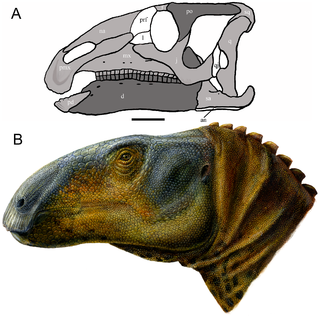
Eolambia is a genus of herbivorous hadrosauroid dinosaur from the early Late Cretaceous of the United States. It contains a single species, E. caroljonesa, named by paleontologist James Kirkland in 1998. The type specimen of Eolambia was discovered by Carole and Ramal Jones in 1993; the species name honors Carole. Since then, hundreds of bones have been discovered from both adults and juveniles, representing nearly every element of the skeleton. All of the specimens have thus far been found in Emery County, Utah, in a layer of rock known as the Mussentuchit Member of the Cedar Mountain Formation.
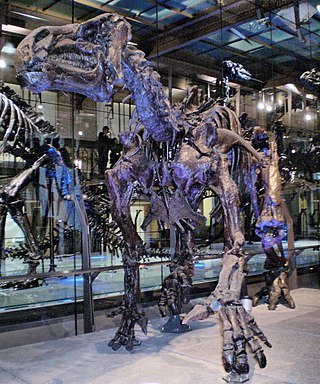
Iguanodontidae is a family of iguanodontians belonging to Styracosterna, a derived clade within Ankylopollexia.

Gilmoreosaurus is the name given to a genus of dinosaur from the Cretaceous of Asia. The type species is Gilmoreosaurus mongoliensis. It is believed to be a hadrosaur or iguanodont from the Iren Dabasu Formation of Inner Mongolia, dating to 96 Ma ago. Additional specimens have been described as distinct species, including G. atavus from the Khodzhakul Formation of Uzbekistan and G. arkhangelskyi from the Bissekty Formation. However, these are based on very fragmentary remains, and their classification is dubious. An additional species, G. kysylkumense is sometimes included, though it has also been referred to the related genus Bactrosaurus.

Theiophytalia is a genus of herbivorous iguanodontian dinosaur from the lower Cretaceous period of Colorado, USA. It contains a single species, T. kerri.

Cedrorestes is a genus of iguanodontian dinosaur from the Early Cretaceous of Utah. It is based on an incomplete skeleton which was found in the Valanginian-age Yellow Cat Member of the Cedar Mountain Formation.

Moabosaurus is a genus of turiasaurian sauropod dinosaur from the Early Cretaceous Cedar Mountain Formation of Utah, United States.
The Cedar Mountain Formation is the name given to a distinctive sedimentary geologic formation in eastern Utah, spanning most of the early and mid-Cretaceous. The formation was named for Cedar Mountain in northern Emery County, Utah, where William Lee Stokes first studied the exposures in 1944.

Suzhousaurus is a genus of large therizinosauroid dinosaur from the Early Cretaceous of China. The genus is known from two specimens discovered on the Xiagou Formation and Zhonggou Formation—which are situated in the Xinminbao Group. These findings were made during field-works in 1999 and 2004. Though Suzhousaurus is known from these two specimens, an earlier named and described therizinosauroid from the adjacent basin, "Nanshiungosaurus" bohlini, may be synonymous with the former. However, Suzhousaurus can not be compared to this species due to non-overlapping material and the loss of the same. Moreover, this synonymy will result in Suzhousaurus bohlini with "N". bohlini having priority.

Peloroplites is a monospecific genus of nodosaurid dinosaur from Utah that lived during the Late Cretaceous in what is now the Mussentuchit Member of the Cedar Mountain Formation. The type and only species, Peloroplites cedrimontanus, is known from a partial skull and postcranial skeleton. It was named in 2008 by Kenneth Carpenter and colleagues. Peloroplites was 6 metres long and weighed 2 tonnes, making it one of the largest known nodosaurids, and came from a time when ankylosaurids and nodosaurids were attaining large sizes.
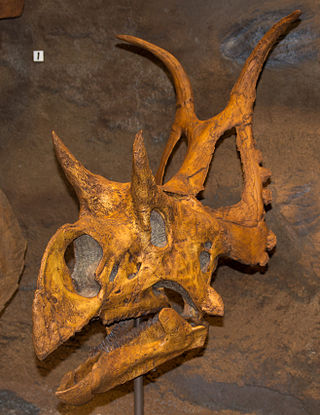
Diabloceratops is an extinct genus of centrosaurine ceratopsian dinosaur that lived approximately 81.4-81 million years ago during the latter part of the Cretaceous Period in what is now Utah, in the United States. Diabloceratops was a medium-sized, moderately built, ground-dwelling, quadrupedal herbivore, that could grow up to an estimated 4.5 metres (15 ft) in length and 1.3 metric tons in body mass. At the time of its discovery, it was the oldest-known ceratopsid, and first centrosaurine known from latitudes south of the U.S. state of Montana. The generic name Diabloceratops means "devil-horned face," coming from Diablo, Spanish for "devil," and ceratops, Latinized Greek for "horned face." The specific name honors Jeffrey Eaton, a paleontologist at Weber State University and long time friend of the lead author Jim Kirkland. Eaton had a big role in establishing the Grand Staircase-Escalante National Monument where the specimen was found. The type species, Diabloceratops eatoni, was named and described in 2010 by James Ian Kirkland and Donald DeBlieux.

Hippodraco is a genus of iguanodontian ornithopod dinosaur from the Early Cretaceous Cedar Mountain Formation of Utah, United States. The genus contains a single species, H. scutodens, known from a partial skeleton belonging to an immature individual.

Geminiraptor is a genus of troodontid theropod dinosaur that lived in North America during the Early Cretaceous period. Geminiraptor was a small, ground-dwelling bipedal carnivorous paravian. The type species of Geminiraptor is G. suarezarum.

Yurgovuchia is a genus of dromaeosaurid theropod dinosaurs that lived in North America during the Early Cretaceous period in what is now the Cedar Mountain Formation. It contains a single species, Yurgovuchia doellingi. The remains were discovered in Utah, United States.
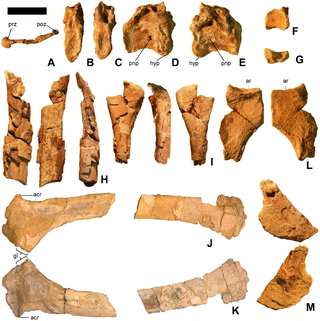
Martharaptor is a genus of therizinosauroid theropod dinosaurs from the Early Cretaceous of the Cedar Mountain Formation in Utah. They can be distinguished from other therizinosauroids by means of several features of the skeleton which were intermediate between early therizinosaurs such as Falcarius and Beipiaosaurus, and more "advanced" members of the group like therizinosaurids. The deep and homogeneous hand claws clearly differ from the case in early therizinosauroids, but the foot has not yet acquired the robust morphology of therizinosaurids.
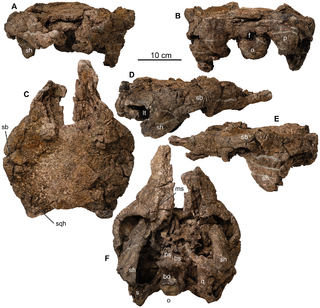
Europelta is a monospecific genus of nodosaurid dinosaur from Spain that lived during the Early Cretaceous in what is now the lower Escucha Formation of the Teruel Province. The type and only species, Europelta carbonensis, is known from two associated partial skeletons, and represents the most complete ankylosaur known from Europe. Europelta was named in 2013 by James I. Kirkland and colleagues. Europelta has an estimated length of 5 metres and weight of 1.3 tonnes, making it the largest member of the clade Struthiosaurini.

Mierasaurus is an extinct genus of sauropod dinosaur from the Early Cretaceous of Utah, United States. The taxon was first described and named in 2017 by Rafael Royo-Torres and colleagues, from a mostly complete skeleton including a disarticulated partial skull and mandible, teeth, multiple vertebrae from along the length of the body, both scapulae, radius and ulna bones, a left manus, a complete pelvis, both femora and the entire left hindlimb. Additionally, they referred a lower jaw and femur from juvenile individuals, which were found nearby, to the genus. Collectively, Mierasaurus is among the most completely known North American sauropods. The genus name honours Bernardo de Miera y Pacheco, the first European scientist to enter what is now Utah. The type species for Mierasaurus is Mierasaurus bobyoungi, named after Robert Glen Young, a paleontologist who researched the Early Cretaceous of Utah.
































